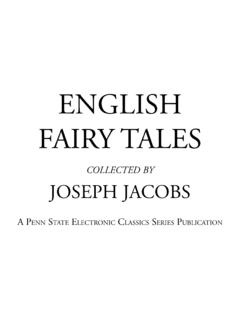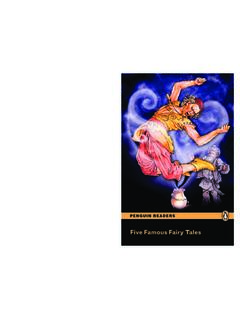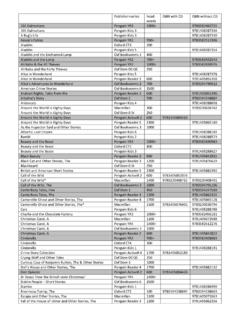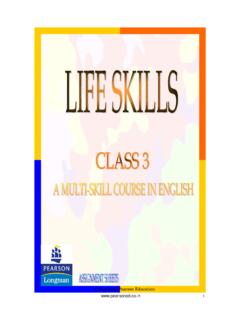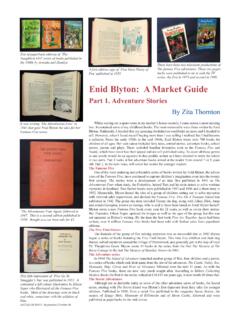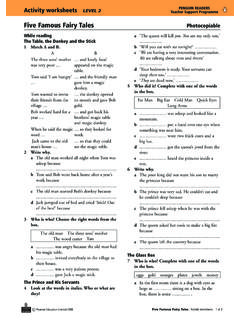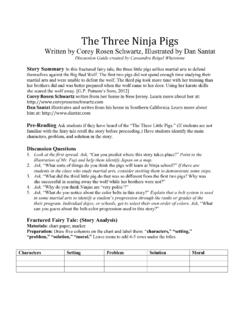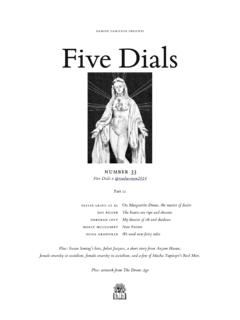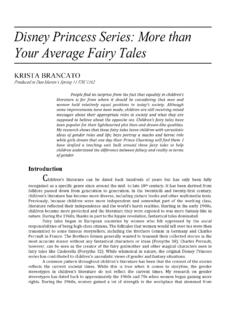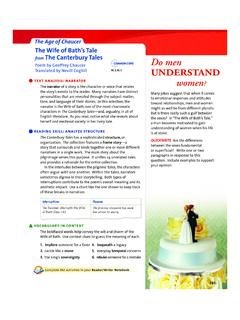Transcription of English Fairy Tales - uCoz
1 ENGLISHFAIRY TALESCOLLECTED BYJOSEPH JACOBSA PENN STATE ELECTRONIC CLASSICS SERIES PUBLICATIONE nglish Fairy Tales Collected by Joseph Jacobs is a publication of the Pennsylvania State Univer-sity. This Portable Document file is furnished free and without any charge of any kind. Anyperson using this document file, for any purpose, and in any way does so at his or her own the Pennsylvania State University nor Jim Manis, Faculty Editor, nor anyone associatedwith the Pennsylvania State University assumes any responsibility for the material containedwithin the document or for the file as an electronic transmission, in any Fairy Tales Collected by Joseph Jacobs, the Pennsylvania State University, ElectronicClassics Series, Jim Manis, Faculty Editor, Hazleton, PA 18202 is a Portable Document File pro-duced as part of an ongoing student publication project to bring classical works of literature, inEnglish, to free and easy access of those wishing to make use of Design: Jim ManisCopyright 2005 The Pennsylvania State UniversityThe Pennsylvania State University is an equal opportunity 5 TOM TIT TOT.
2 9 THE THREE SILLIES .. 13 THE ROSE-TREE .. 16 THE OLD WOMAN AND HER PIG .. 19 HOW JACK WENT TO SEEK .. 21 HIS FORTUNE .. 21MR. VINEGAR .. 23 NIX NOUGHT NOTHING .. 26 JACK HANNAFORD .. 32 MOUSE AND MOUSER .. 34 CAP O RUSHES .. 39 JACK AND THE BEANSTALK .. 40 THE MASTER AND HIS PUPIL .. 48 TITTY MOUSE AND TATTY MOUSE .. 50 JACK AND HIS GOLDEN SNUFF-BOX .. 52 THE STORY OF THE THREE BEARS .. 60 JACK THE GIANT-KILLER .. 73 CHILDE ROWLAND .. 75 MOLLY WHUPPIE .. 80 THE RED ETTIN .. 83 THE GOLDEN ARM .. 88 THE HISTORY OF TOM THUMB .. 89MR. FOX .. 94 LAZY JACK .. 97 JOHNNY-CAKE .. 99 EARL MAR S DAUGHTER .. 101MR. MIACCA .. 104 WHITTINGTON AND HIS CAT .. 105 THE STRANGE VISITOR .. 113 THE LAIDLY WORM .. 115OF SPINDLESTON HEUGH .. 115 THE CAT AND THE MOUSE .. 118 THE FISH AND THE RING .. 120 THE MAGPIE S NEST .. 123 KATE CRACKERNUTS .. 124 THE CAULD LAD OF HILTON .. 127 THE ASS, THE TABLE, AND THE STICK .. 129 Fairy OINTMENT .. 132 THE WELL OF THE WORLD S END .. 134 MASTER OF ALL MASTERS.
3 137 THE THREE HEADS OF THE WELL .. 138 NOTES AND REFERENCES .. 1425 Joseph JacobsENGLISHFAIRY TALESCOLLECTED BYJOSEPH JACOBSHOW TO GET INTO THIS BOOK. Knock at the Knocker on the Door, Pull the Bell at the side,Then, if you are very quiet, you will hear a teeny tiny voice saythrough the grating Take down the Key. This you will find atthe back: you cannot mistake it, for it has J. J. in the wards. Putthe Key in the Keyhole, which it fits exactly, unlock the door andWALK MY DEAR LITTLE MAYP refaceWHO SAYS that English folk have no Fairy - Tales of their own?The present volume contains only a selection out of some140, of which I have found traces in this country. It is prob-able that many more quarter of the Tales in this volume, have been collectedduring the last ten years or so, and some of them have notbeen hitherto published. Up to 1870 it was equally said ofFrance and of Italy, that they possessed no folk- Tales . Yet,within fifteen years from that date, over 1000 Tales had beencollected in each country.
4 I am hoping that the present vol-ume may lead to equal activity in this country, and wouldearnestly beg any reader of this book who knows of similartales, to communicate them, written down as they are told,to me, care of Mr. Nutt. The only reason, I imagine, whysuch Tales have not hitherto been brought to light, is thelamentable gap between the governing and recording classesand the dumb working classes of this country dumb toothers but eloquent among themselves. It would be no un-patriotic task to help to bridge over this gulf, by giving a6 English Fairy Talescommon fund of nursery literature to all classes of the En-glish people, and, in any case, it can do no harm to add tothe innocent gaiety of the word or two as to our title seems necessary. We havecalled our stories Fairy Tales though few of them speak offairies.* The same remark applies to the collection of theBrothers Grimm and to all the other European collections,which contain exactly the same classes of Tales as ours.
5 Yetour stories are what the little ones mean when they clamourfor Fairy Tales , and this is the only name which they giveto them. One cannot imagine a child saying, Tell us a folk-tale, nurse, or Another nursery tale, please, grandma. Asour book is intended for the little ones, we have indicated itscontents by the name they use. The words Fairy Tales mustaccordingly be taken to include Tales in which occurs some-thing Fairy , something extraordinary fairies, giants,dwarfs, speaking animals. It must be taken also to cover talesin which what is extraordinary is the stupidity of some ofthe actors. Many of the Tales in this volume, as in similarcollections for other European countries, are what the folk-lorists call Drolls. They serve to justify the title of MerrieEngland, which used to be given to this country of ours, andindicate unsuspected capacity for fun and humour amongthe unlettered classes. The story of Tom Tit Tot, which opensour collection, is unequalled among all other folk- Tales I amacquainted with, for its combined sense of humour and dra-matic first adjective of our title also needs a similar exten-sion of its meaning.
6 I have acted on Moli re s principle, andhave taken what was good wherever I could find it. Thus, acouple of these stories have been found among descendantsof English immigrants in America; a couple of others I tell asI heard them myself in my youth in Australia. One of thebest was taken down from the mouth of an English Gipsy. Ihave also included some stories that have only been found inLowland Scotch. I have felt justified in doing this, as of thetwenty-one folk- Tales contained in Chambers PopularRhymes of Scotland, no less than sixteen are also to be foundin an English form. With the Folk-tale as with the Ballad,Lowland Scotch may be regarded as simply a dialect of En-*For some recent views on fairies and Tales about fairies, Jacobsglish, and it is a mere chance whether a tale is extant in oneor other, or have also rescued and re-told a few Fairy Tales that onlyexist now-a-days in the form of ballads. There are certain in-dications that the common form of the English Fairy Talewas the cante-fable, a mixture of narrative and verse of whichthe most illustrious example in literature is Aucassin etNicolette.
7 In one case I have endeavoured to retain this form,as the tale in which it occurs, Childe Rowland, is mentionedby Shakespeare in King Lear, and is probably, as I have shown,the source of Milton s Comus. late as they have been collected,some dozen of the Tales can be traced back to the sixteenthcentury, two of them being quoted by Shakespeare the majority of instances I have had largely to rewritethese Fairy Tales , especially those in dialect, including theLowland Scotch.* Children, and sometimes those of largergrowth, will not read dialect. I have also had to reduce theflatulent phraseology of the eighteenth-century chap-books,and to re-write in simpler style the stories only extant in Literary English . I have, however, left a few vulgarisms inthe mouths of vulgar people. Children appreciate the dra-matic propriety of this as much as their elders. Generallyspeaking, it has been my ambition to write as a good oldnurse will speak when she tells Fairy Tales .
8 I am doubtful asto my success in catching the colloquial-romantic tone ap-propriate for such narratives, but the thing had to be doneor else my main object, to give a book of English Fairy Taleswhich English children will listen to, would have beenunachieved. This book is meant to be read aloud, and notmerely taken in by the a few instances I have introduced or changed an inci-dent. I have never done so, however, without mentioningthe fact in the Notes. These have been relegated to the ob-scurity of small print and a back place, while the little oneshave been, perhaps unnecessarily, warned off them. Theyindicate my sources and give a few references to parallelsand variants which may be of interest to fellow-students of*It is perhaps worth remarking that the Brothers Grimm did thesame with their stories. Dass der Ausdruck, say they in theirPreface, und die Ausf hrung des Einzelnen grossentheils von unsherr hrt, versteht sich von selbst.
9 I may add that many of theirstories were taken from printed sources. In the first volume ofMrs. Hunt s translation, Nos. 12, 18, 19, 23, 32, 35, 42, 43, 44,69, 77, 78, 83, 89, are thus Fairy TalesFolk-lore. It is, perhaps, not necessary to inform readers whoare not fellow-students that the study of Folk- Tales has pre-tensions to be a science. It has its special terminology, and itsown methods of investigation, by which it is hoped, one ofthese days, to gain fuller knowledge of the workings of thepopular mind as well as traces of archaic modes of thoughtand custom. I hope on some future occasion to treat thesubject of the English Folk-tale on a larger scale and with allthe necessary paraphernalia of prolegomena and excursus. Ishall then, of course, reproduce my originals with literal ac-curacy, and have therefore felt the more at liberty on thepresent occasion to make the necessary deviations from thisin order to make the Tales readable for , I have to thank those by whose kindness in waiv-ing their rights to some of these stories, I have been enabledto compile this book.
10 My friends Mr. E. Clodd, Mr. F. HindesGroome, and Mr. Andrew Lang, have thus yielded up to mesome of the most attractive stories in the following Councils of the English and of the American Folk-loreSocieties, and Messrs. Longmans, have also been equallygenerous. Nor can I close these remarks without a word ofthanks and praise to the artistic skill with which my friend,Mr. J. D. Batten, has made the romance and humour ofthese stories live again in the brilliant designs with which hehas adorned these pages. It should be added that the daintyheadpieces to Henny Penny and Mr. Fox are due to myold friend, Mr. Henry JacobsTOM TIT TOTONCE UPON A TIME there was a woman, and she baked fivepies. And when they came out of the oven, they were thatoverbaked the crusts were too hard to eat. So she says to herdaughter: Darter, says she, put you them there pies on the shelf,and leave em there a little, and they ll come again. Shemeant, you know, the crust would get the girl, she says to herself: Well, if they ll come again,I ll eat em now.
